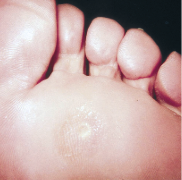What is porokeratosis?
Porokeratosis is an uncommon diagnosis. It usually occurs on sun-exposed skin, most commonly after the age of 50, but can occur at any age and similar frequencies in males and females. The increased occurrence of disseminated superficial actinic porokeratosis on sun-exposed skin likely indicates that ultraviolet light is a risk factor.
How does porokeratosis appear on the foot or ankle?
The most common assumed cause of porokeratosis on the foot, is from clogged sweat glands in the foot. Sometimes when you combine the pressure and friction on the foot with debris and dead skin, those glands will clog. Because the gland is so deep in the skin layers, this pain feels like it’s very deep down in the foot, which is why the grinding down of the surface callus down does not provide relief.
How do you treat porokeratosis of the foot?
Treatment options involve cushioning the area of pain with insoles and controlling the amount the feet sweat by using drying powders. However, those treatment options are usually best used as preventative medicine once you’ve had the area treated by your podiatrist. We will likely perform curetting of the lesion which should not cause you pain. Other options we may offer for treatment are injections into the area.
Helpful tips to manage the care of porokeratosis
To help manage the problem, you should limit sun exposure to the lesion-prone lower limbs. Keep them covered when you can and wear soft, breathable shoes. Wash and actively moisturize your feet daily to help combat dryness and clogging.
